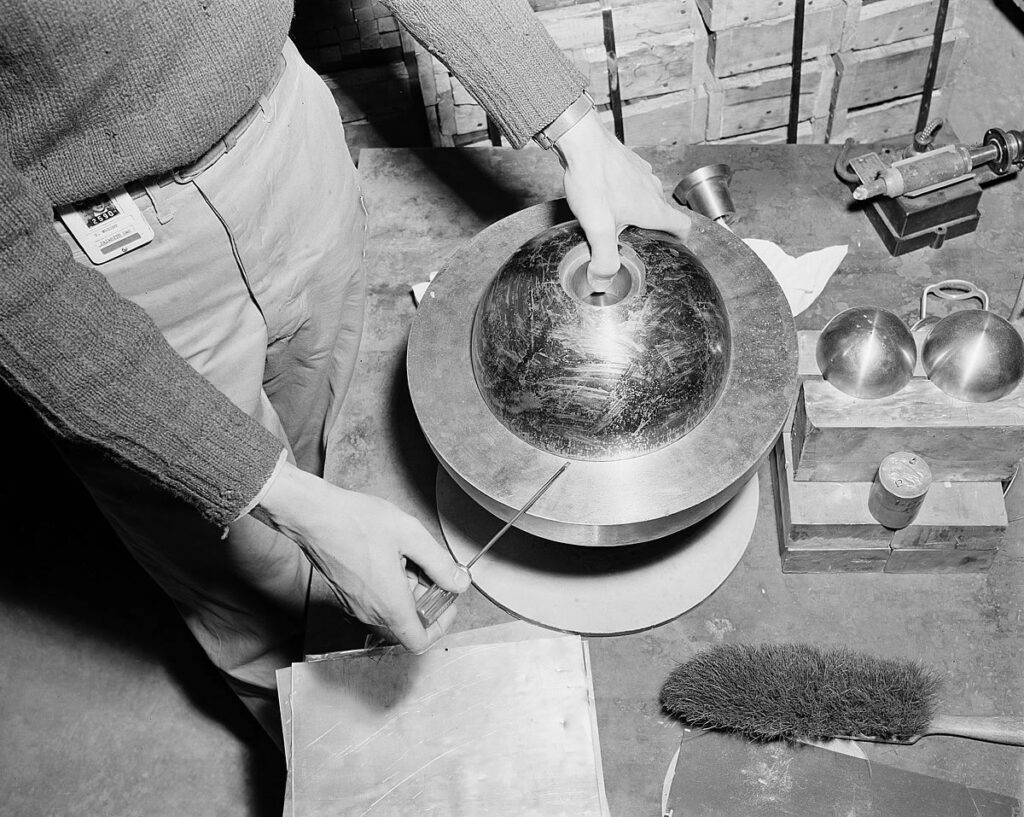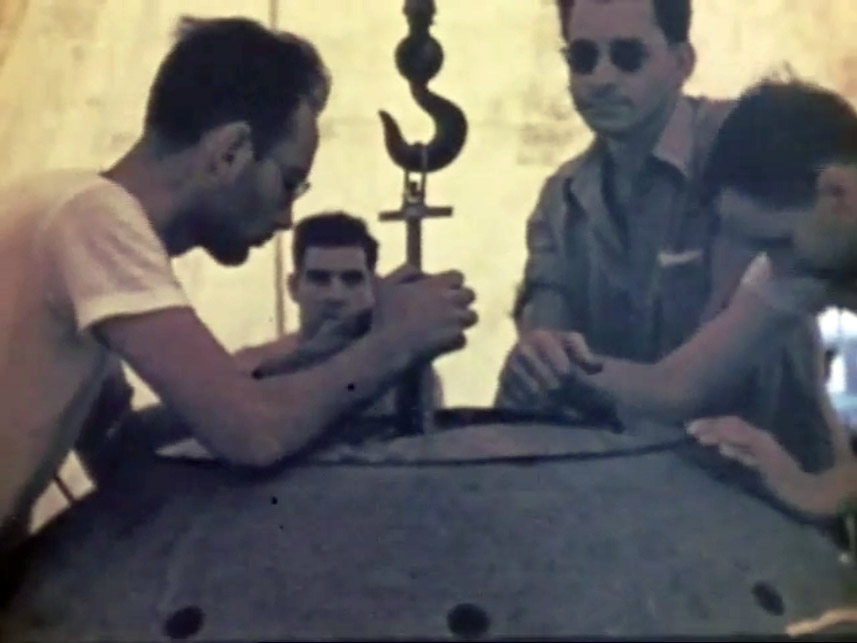The modern history of science is rife with nuclear accidents.
Amidst the tumultuous landscape of the mid-20th century – a pivotal time when great powers vied for supremacy, driven by clandestine nuclear discovery – these accidents were far too common.
It was during this extraordinary, dangerous epoch that an infamous entity emerged – the demon core.
Its name belies its reputation. This notorious mass of plutonium-239 emerged during the critical years of the Manhattan Project, as the United States worked tirelessly to harness the power of the Sun.
But, this came at a grave cost. Tragically, the demon core etched its name into history with a series of harrowing nuclear accidents that shocked the scientific community and the world.
What led to these cataclysmic events? How did they shape our understanding of nuclear safety and what lessons can we learn for the future?

What is the Demon Core?
The demon core is a 6.2-kilogram subcritical mass of plutonium. It holds a dark and compelling legacy in nuclear history.
It was created during World War II as a potential fissile core for an early nuclear bomb as part of the Manhattan Project. Its story took a dramatic turn when Japan surrendered.
It was retained at Los Alamos National Laboratory for further testing and potential future use. But fate had other plans for this ominous sphere.
Before long, a nuclear accident had struck not once, but twice. From August 1945 to late May 1946, the plutonium core was involved in two critical experiments at Los Alamos.
The first incident occurred on August 21, 1945, under the study of physicist Harry Daghlian. While conducting neutron reflection experiments, Daghlian committed a fatal error and he suffered a fatal dose of radiation.
In the second accident on May 21, 1946, physicist Louis Slotin was assembling two halves of a reflective beryllium sphere around the core when another fatal mishap occurred. Slotin acted heroically, but unfortunately, he was also fatally exposed.
Together, the two incidents gave the demon core its chilling nickname. Eventually, the core was melted down. But the lessons learned from its tragic history continue to influence nuclear safety practices to this day.
Studying Nuclear Reactions
The origins of the demon core can be traced back to the Manhattan Project during World War II.
It was assembled as a solid sphere of two plutonium-gallium hemispheres. It weighed in at 6.2 kilograms. The fissile core was a crucial component of early nuclear weapons.
This one, in particular, was prepared specifically for a third nuclear weapon, after the two dropped at Hiroshima and Nagasaki.
They used refined plutonium from Washington state. This was then shipped to the Los Alamos National Laboratory where skilled engineers, physicists, and scientists quickly got to work on manufacturing the core.
According to records, the third core was set to be ready for delivery by August 16. The subsequent nuclear bomb was dropped days later, on the 19th.
Plans were underway for its deployment. The surrender of Japan on August 15, 1945, intervened in these plans, halting any further usage of the third atomic bomb.
Consequently, the yet-to-be-named plutonium core remained at Los Alamos. It serves as a sobering reminder of the destructive potential of nuclear bombs, as well as a potential object of scientific study and testing.
The Harry Daghlian Accident
On a fateful Tuesday, August 21, 1945, physicist Harry Daghlian found himself working late into the night experimenting with the core. He sought to construct a neutron reflector around it, aiming to gauge its proximity to the ‘critical point.’
In solitude, Daghlian carefully added tungsten carbide bricks around it, but a momentary lapse led to a catastrophic mishap. In the blink of an eye, a brick slipped from his grasp, onto the core, triggering a surge of neutron radiation and sending it into a critical chain reaction.
Swiftly reacting, Daghlian disassembled the setup, but it was too late. His exposure to the powerful radiation was beyond lethal. He succumbed to acute radiation poisoning 25 days later in his hospital room.
This, and other experiments, would be known as “Tickling the Dragon’s Tail,” as scientists like Daghlian engaged in perilous pursuits to explore the core’s critical properties.
Unfortunately, Daghlian was not the only victim of the demon core and its dangers.
The Louis Slotin Accident
Less than a year later, on May 21, 1946, in a Los Alamos laboratory, physicist Louis Slotin also found himself in the midst of a criticality experiment with potentially lethal consequences. And it was with the same plutonium core.
Slotin demonstrated the technique to a colleague. His setup involved carefully bringing together two half-spheres of beryllium reflector shells. All the while, he maintained a delicate separation to avoid a critical chain reaction.
Tragically, in a single, fateful moment, Slotin’s screwdriver slipped. The halves came dangerously close to touching.
In a flash of blue light, the Geiger counter erupted. This indicated nearly 1,000 rads of radiation exposure – an amount well above a lethal dose.
Quickly acting to avert disaster, Slotin instinctively separated the spheres. This halted the chain reaction and prevented his colleagues from facing the same perilous exposure.
However, his bravery came at a tremendous cost. In the following days, Slotin’s health deteriorated rapidly. He succumbed to the ravages of radiation sickness on May 30, 1946.
The experimenters’ “Tickling the Dragon’s Tail” with the demon cores had struck again.

The Ultimate Fate of the Demon Core
After its tragic involvement in the criticality accidents that claimed the lives of Harry Daghlian and Louis Slotin, the demon core faced an uncertain fate.
The core was left behind at Los Alamos National Laboratory. It had been slated for use in an atomic bomb as part of the Operation Crossroads nuclear tests.
However, following the accidents, the core’s radioactivity needed time to decline. Its effects on the nuclear material it held required re-evaluation – a complicated assessment given the inherent dangers.
After the first two tests of Operation Crossroads, “Able” and “Baker,” the core was slated for the “Charlie” test. However, this was ultimately canceled due to the unexpected radioactivity levels resulting from the underwater “Baker” test.
In the end, the demon core’s material was eventually melted down in the summer of 1946. It was recycled for use in other cores, effectively bringing an end to its eerie and ominous journey.
References
“Atomic Accidents.” Nuclear Museum, June 4, 2014. https://ahf.nuclearmuseum.org/ahf/history/atomic-accidents/.
“The Demon Core.” IOPSpark. Accessed July 20, 2023. https://spark.iop.org/demon-core.
Wellerstein, Alex. “The Demon Core and the Strange Death of Louis Slotin.” The New Yorker, May 21, 2016. https://www.newyorker.com/tech/annals-of-technology/demon-core-the-strange-death-of-louis-slotin.

